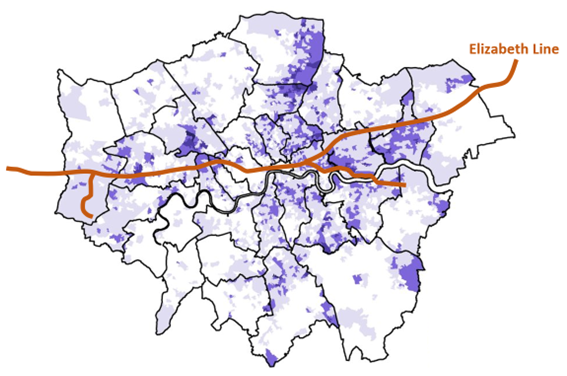The Elizabeth line will finally open on 24 May, three and a half years later than originally planned. Back in 2018, when it was due to open, the overriding concern was that rail infrastructure was not keeping up with commuter demand into central London and was choking the capital’s economic growth. But in a post-Covid, hybrid work embracing Britain, this may no longer be a valid concern.
The 2011 business case indicated £1.97 in transport benefits for every £1 in costs. On the cost side, the total bill has now been estimated at £18.9bn, against a budget of £14.8bn1. Crucially, just under half of the estimated user benefits were associated with reduced congestion and crowding on the transport network – if these benefits are reduced, the strength of the case becomes highly dependent on the generation of wider economic benefits2.
Weekday travel on the London Underground network with which the Elizabeth Line will interact is at just 60% of pre-pandemic levels, rising to 80% at weekends3. Five-day peak hour commuting – once a reliable cash cow – is at just 15% of its pre-pandemic level, and overall commuter journeys stand at just 45% of what they were nationally4. In an age of face-to-face meetings, fast connections between Heathrow, Canary Wharf, Stratford, the City, and the West End made a great deal of sense – but the rise of video calling has reduced this need. Leisure travel has rebounded more strongly, but this does not create the same concentrated peaks of demand and therefore capacity challenges that commuting can.
So, the Elizabeth Line’s impact on the number of people working in central London will probably be less significant than hoped for. It can still, however, affect where those workers live, and therefore the socio-economic fortunes of some of the capital’s poorest areas. In anticipation of the line’s opening, residential, commercial and retail development along the route has accelerated over the last decade, and the full effects of this may soon be apparent. The places affected include some of London’s largest ‘Opportunity Areas’5 along the eastern extent of the Thames, plus areas around the Essex/London border. These locations are characterised by relatively high deprivation compared to the rest of London; as shown on the below map, the eastern parts of the Elizabeth Line overlap fairly well with relatively more deprived parts of the city (shown in dark purple).
An influx of well-paid workers could be exactly what these areas need. Admittedly, upward pressure on property prices6 is unwelcome for those already renting there. But high earners are high spenders, and will create growth and employment around their new homes. Of course, this was known prior to the pandemic, and no doubt informed decisions over the route of the Elizabeth Line. What we did not know is that post-pandemic ways of working could increase these benefits beyond initial expectations. Employees only in the office two or three days a week will do more of their shopping, socialising, and therefore spending around their homes rather than their workplaces. This further supports the economic fortunes of their communities much more effectively than they would as full-time commuters – albeit at the expense of retail and hospitality in wealthier central London localities.
Of course, the full realisation of these benefits to deprived areas relies on white-collar workers continuing to spend much of their working time at home. If pre-pandemic norms return, distributional benefits will be smaller and the new capacity necessary after all. If not, the silver lining is that the combination of the Elizabeth Line and home working will serve to ‘Level up’ struggling parts of London.
3 https://www.railjournal.com/news/british-passenger-rail-numbers-reach-80-of-pre-covid-levels/
4 https://cps.org.uk/research/changing-track/
5 Those identified in the London Plan as having potential for housing and infrastructure development. See https://www.london.gov.uk/what-we-do/planning/implementing-london-plan/opportunity-areas/londons-opportunity-areas
6 https://www.benhams.com/press-release/london-property-market/crossrail-house-prices-up/ – estimated 14% premium for postcodes around Elizabeth Line stations compared to their wider areas
For more information please contact:
Rowlando Morgan, Head of Environment, Infrastructure & Local Growth Email rmorgan@cebr.com Phone 020 7324 2850
Robert Beauchamp, Senior Economist Email rbeauchamp@cebr.com Phone 07729 924949
Cebr is an independent London-based economic consultancy specialising in economic impact assessment, macroeconomic forecasting and thought leadership. For more information on this report, or if you are interested in commissioning research with Cebr, please contact us using our enquiries page.

